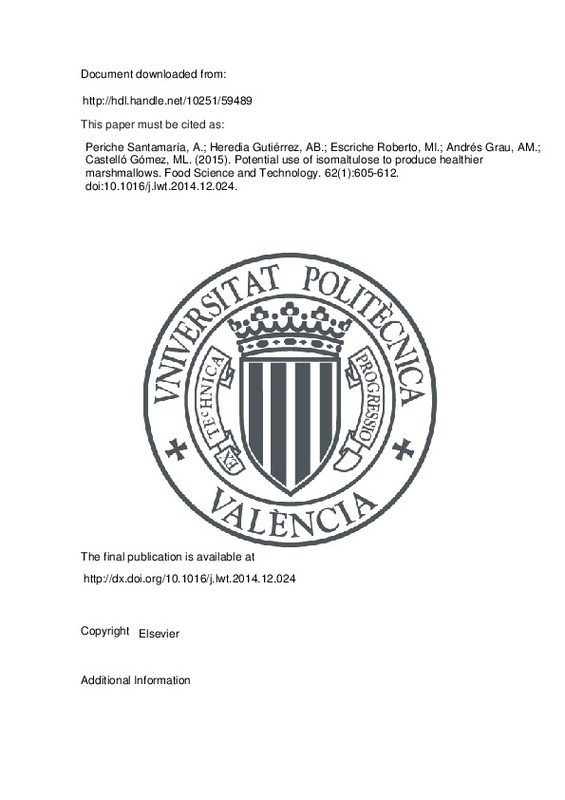JavaScript is disabled for your browser. Some features of this site may not work without it.
Buscar en RiuNet
Listar
Mi cuenta
Estadísticas
Ayuda RiuNet
Admin. UPV
Potential use of isomaltulose to produce healthier marshmallows
Mostrar el registro sencillo del ítem
Ficheros en el ítem
| dc.contributor.author | Periche Santamaría, Angela
|
es_ES |
| dc.contributor.author | Heredia Gutiérrez, Ana Belén
|
es_ES |
| dc.contributor.author | Escriche Roberto, Mª Isabel
|
es_ES |
| dc.contributor.author | Andrés Grau, Ana María
|
es_ES |
| dc.contributor.author | Castelló Gómez, María Luisa
|
es_ES |
| dc.date.accessioned | 2016-01-07T09:33:17Z | |
| dc.date.available | 2016-01-07T09:33:17Z | |
| dc.date.issued | 2015-06 | |
| dc.identifier.issn | 0023-6438 | |
| dc.identifier.uri | http://hdl.handle.net/10251/59489 | |
| dc.description.abstract | Isomaltulose is a non-cariogenic sugar with a lower glycemic index but with the same caloric value and visual appearance as sucrose. Therefore, isomaltulose could potentially be used to produce healthier candies. In this regard, the aim of this research was to evaluate isomaltulose as a traditional sugar replacer in soft marshmallow type candies, in order to provide added value to these widely consumed products, making it possible to capture a new market niche. 18 formulations were studied combining different sugars (sucrose, glucose syrup, fructose and isomaltulose) and different percentages of gelatine (4, 5 and 6). Analyses of composition (degrees Brix and moisture content), pH and water activity (a(w)), instrumental colour and texture as well as a sensorial analysis were performed. Marshmallows with isomaltulose combined with fructose exhibited the lowest values of pH (4.99-5.14). Moreover, formulations with similar amount of isomaltulose and fructose presented lower instrumental hardness, higher cohesiveness and springiness, and the best sensory acceptance. A PLS multivariate analysis showed a good correlation between instrumental and sensory mechanical parameters. Therefore, instrumental measures of texture could be suitable for discerning an overall preference for marshmallows without using trained panellists. (C) 2014 Elsevier Ltd. All rights reserved. | es_ES |
| dc.description.sponsorship | The authors thank the Universitat Politecnica de Valencia for funding the project PAID 2011-ref: 2012 and the PhD scholarship. | en_EN |
| dc.language | Inglés | es_ES |
| dc.publisher | Elsevier | es_ES |
| dc.relation.ispartof | Food Science and Technology | es_ES |
| dc.rights | Reserva de todos los derechos | es_ES |
| dc.subject | Marshmallows | es_ES |
| dc.subject | Isomaltulose | es_ES |
| dc.subject | Fructose | es_ES |
| dc.subject | Non-cariogenic | es_ES |
| dc.subject | Glycemic index and insulinemic index | es_ES |
| dc.subject.classification | TECNOLOGIA DE ALIMENTOS | es_ES |
| dc.title | Potential use of isomaltulose to produce healthier marshmallows | es_ES |
| dc.type | Artículo | es_ES |
| dc.identifier.doi | 10.1016/j.lwt.2014.12.024 | |
| dc.relation.projectID | info:eu-repo/grantAgreement/UPV//PAID-2011-2012/ | es_ES |
| dc.rights.accessRights | Abierto | es_ES |
| dc.contributor.affiliation | Universitat Politècnica de València. Instituto Universitario de Ingeniería de Alimentos para el Desarrollo - Institut Universitari d'Enginyeria d'Aliments per al Desenvolupament | es_ES |
| dc.contributor.affiliation | Universitat Politècnica de València. Departamento de Tecnología de Alimentos - Departament de Tecnologia d'Aliments | es_ES |
| dc.description.bibliographicCitation | Periche Santamaría, A.; Heredia Gutiérrez, AB.; Escriche Roberto, MI.; Andrés Grau, AM.; Castelló Gómez, ML. (2015). Potential use of isomaltulose to produce healthier marshmallows. Food Science and Technology. 62(1):605-612. https://doi.org/10.1016/j.lwt.2014.12.024 | es_ES |
| dc.description.accrualMethod | S | es_ES |
| dc.relation.publisherversion | http://dx.doi.org/10.1016/j.lwt.2014.12.024 | es_ES |
| dc.description.upvformatpinicio | 605 | es_ES |
| dc.description.upvformatpfin | 612 | es_ES |
| dc.type.version | info:eu-repo/semantics/publishedVersion | es_ES |
| dc.description.volume | 62 | es_ES |
| dc.description.issue | 1 | es_ES |
| dc.relation.senia | 277814 | es_ES |
| dc.contributor.funder | Universitat Politècnica de València | es_ES |







![[Cerrado]](/themes/UPV/images/candado.png)

